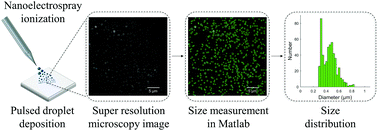Our official English website, www.x-mol.net, welcomes your
feedback! (Note: you will need to create a separate account there.)
Sizing sub-diffraction limit electrosprayed droplets by structured illumination microscopy
Analyst ( IF 3.6 ) Pub Date : 2017-11-08 00:00:00 , DOI: 10.1039/c7an01278k Adam Hollerbach 1, 2, 3, 4 , David Logsdon 1, 2, 3, 4 , Kiran Iyer 1, 2, 3, 4 , Anyin Li 1, 2, 3, 4 , J. Andy Schaber 2, 3, 4, 5, 6 , R. Graham Cooks 1, 2, 3, 4
Analyst ( IF 3.6 ) Pub Date : 2017-11-08 00:00:00 , DOI: 10.1039/c7an01278k Adam Hollerbach 1, 2, 3, 4 , David Logsdon 1, 2, 3, 4 , Kiran Iyer 1, 2, 3, 4 , Anyin Li 1, 2, 3, 4 , J. Andy Schaber 2, 3, 4, 5, 6 , R. Graham Cooks 1, 2, 3, 4
Affiliation

|
Electrosprayed droplets are widely studied for their role in the formation of ions at atmospheric pressure. Most droplet measurement methods used today employ light scattering to infer information about an electrosprayed droplet's size. However, these methods fail to measure droplets smaller than about 400 nm in diameter due to constraints imposed by the diffraction limit of light. To overcome this limitation, a super resolution fluorescence microscopy-based method for determining the sizes of electrosprayed droplets has been developed. Solutions containing rhodamine B and different amounts of glycerol were paper sprayed and nanoelectrosprayed onto conductive microscope coverslips using a single, high voltage pulse. Images of the deposited droplets were collected using a super resolution microscope operating in 3D structured illumination microscopy mode (3D-SIM). The sizes of droplets were measured using a modified circular Hough transformation program in Matlab. On average, the diameters of paper sprayed droplets were between 500 nm and 2 μm while almost all nanoelectrosprayed droplets were smaller than 1 μm. The center of a paper spray plume exhibited larger droplets than those at the periphery, likely due to greater Coulombic repulsive forces acting on the smaller droplets to drive them outwards. The periphery also likely contained progeny droplets in addition to smaller parent droplets. It was possible to alter the sizes of nanoelectrosprayed droplets in several ways, including by changing the solvent composition and voltage applied to the emitter. Droplets consisting of high concentrations of glycerol were larger than droplets containing high concentrations of methanol, presumably due to the high surface tension of glycerol. Correspondingly, droplets became smaller when the voltage applied to the emitter was increased, likely due to the ability to overcome the surface tension of the solvent more easily. The smallest detectable droplets confidently measured with this method were 200 nm in diameter. This method demonstrates a new way of measuring the sizes of electrosprayed droplets with half the diameter of conventional droplet size measurement methods. Through further optimization, it may be possible to measure the sizes of electrosprayed droplets as small as the theoretical resolution limit of SIM (∼100 nm).
中文翻译:

通过结构照明显微镜确定亚衍射极限电喷雾液滴的尺寸
电喷雾液滴在大气压下离子形成中的作用已得到广泛研究。当今使用的大多数液滴测量方法都是利用光散射来推断有关电喷雾液滴尺寸的信息。然而,由于光的衍射极限的限制,这些方法无法测量直径小于约400nm的液滴。为了克服该限制,已经开发了用于确定电喷雾液滴尺寸的基于超分辨率荧光显微镜的方法。使用单个高压脉冲,将含有若丹明B和不同量甘油的溶液喷到纸上,并进行纳米电喷雾到导电显微镜盖玻片上。使用在3D结构化照明显微镜模式(3D-SIM)下运行的超分辨率显微镜收集沉积液滴的图像。液滴的大小是使用Matlab中经过修改的圆形Hough变换程序测量的。平均而言,纸喷雾液滴的直径在500 nm至2μm之间,而几乎所有纳米电喷雾液滴的直径均小于1μm。纸雾羽流的中心比外围的雾流更大,这可能是由于更大的库仑排斥力作用于较小的雾滴以将其向外驱散。除了较小的亲代小滴外,外围还可能包含子代小滴。可以通过几种方式改变纳米电喷雾液滴的尺寸,包括通过改变溶剂成分和施加在发射体上的电压。推测是由于甘油的高表面张力,由高浓度的甘油组成的液滴比含有高浓度的甲醇的液滴大。相应地,当增加施加到发射体的电压时,液滴变得更小,这可能是由于能够更轻松地克服溶剂的表面张力的缘故。用此方法可靠地测量出的最小可检测液滴直径为200 nm。该方法演示了一种测量电喷雾液滴尺寸的新方法,其直径仅为传统液滴尺寸测量方法的一半。通过进一步的优化,可以测量出电喷雾液滴的尺寸,使其小至SIM的理论分辨率极限(〜100 nm)。
更新日期:2017-11-15
中文翻译:

通过结构照明显微镜确定亚衍射极限电喷雾液滴的尺寸
电喷雾液滴在大气压下离子形成中的作用已得到广泛研究。当今使用的大多数液滴测量方法都是利用光散射来推断有关电喷雾液滴尺寸的信息。然而,由于光的衍射极限的限制,这些方法无法测量直径小于约400nm的液滴。为了克服该限制,已经开发了用于确定电喷雾液滴尺寸的基于超分辨率荧光显微镜的方法。使用单个高压脉冲,将含有若丹明B和不同量甘油的溶液喷到纸上,并进行纳米电喷雾到导电显微镜盖玻片上。使用在3D结构化照明显微镜模式(3D-SIM)下运行的超分辨率显微镜收集沉积液滴的图像。液滴的大小是使用Matlab中经过修改的圆形Hough变换程序测量的。平均而言,纸喷雾液滴的直径在500 nm至2μm之间,而几乎所有纳米电喷雾液滴的直径均小于1μm。纸雾羽流的中心比外围的雾流更大,这可能是由于更大的库仑排斥力作用于较小的雾滴以将其向外驱散。除了较小的亲代小滴外,外围还可能包含子代小滴。可以通过几种方式改变纳米电喷雾液滴的尺寸,包括通过改变溶剂成分和施加在发射体上的电压。推测是由于甘油的高表面张力,由高浓度的甘油组成的液滴比含有高浓度的甲醇的液滴大。相应地,当增加施加到发射体的电压时,液滴变得更小,这可能是由于能够更轻松地克服溶剂的表面张力的缘故。用此方法可靠地测量出的最小可检测液滴直径为200 nm。该方法演示了一种测量电喷雾液滴尺寸的新方法,其直径仅为传统液滴尺寸测量方法的一半。通过进一步的优化,可以测量出电喷雾液滴的尺寸,使其小至SIM的理论分辨率极限(〜100 nm)。









































 京公网安备 11010802027423号
京公网安备 11010802027423号